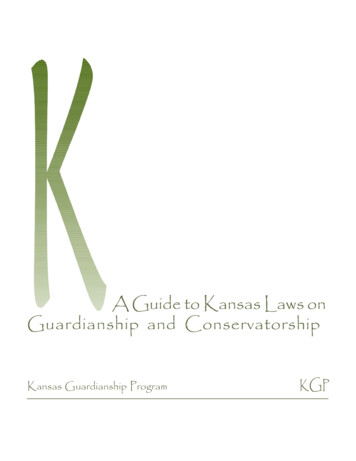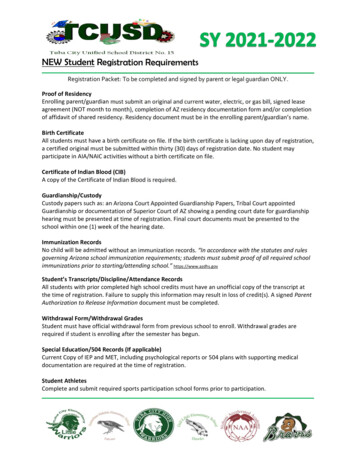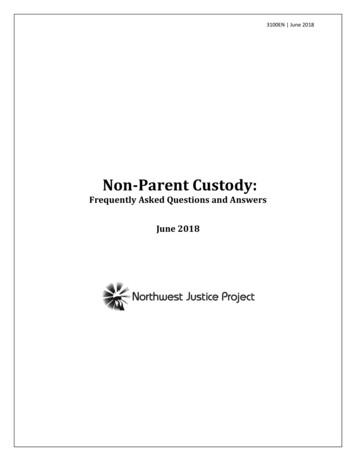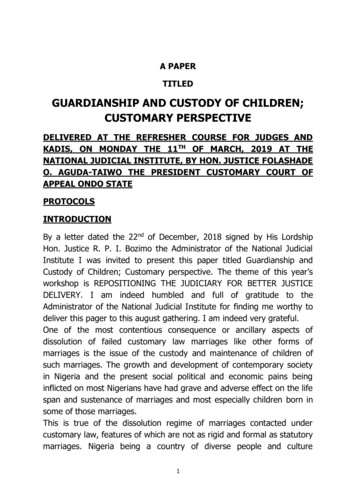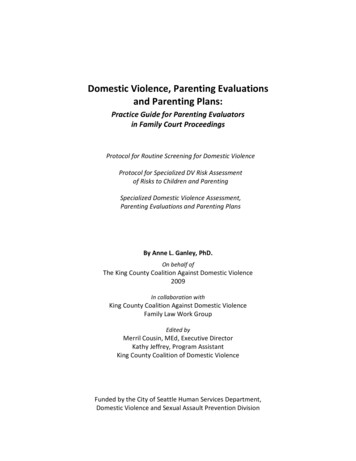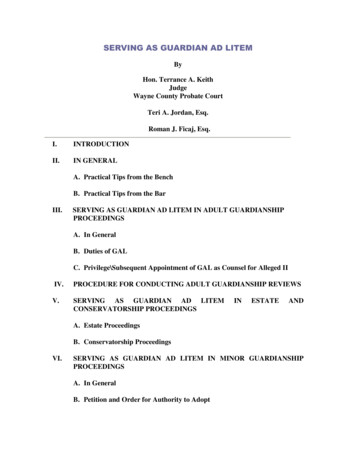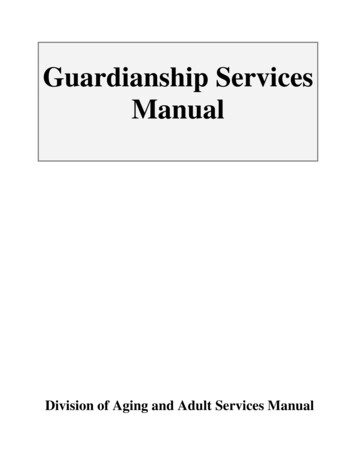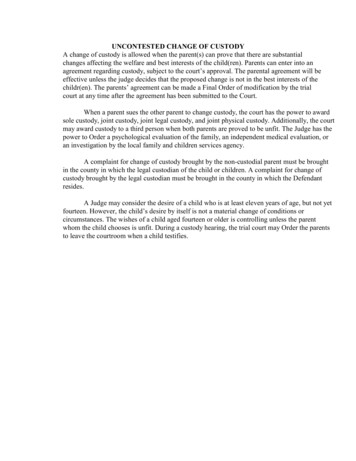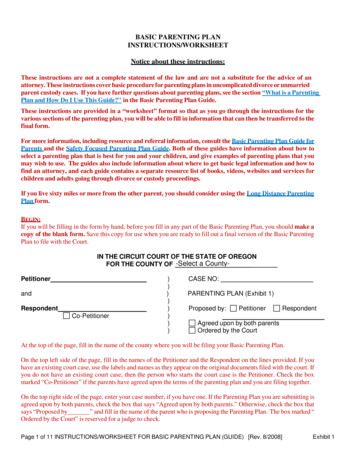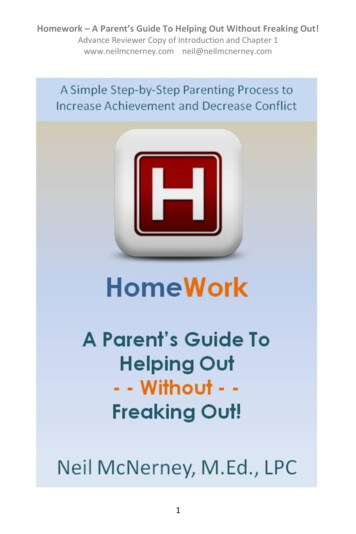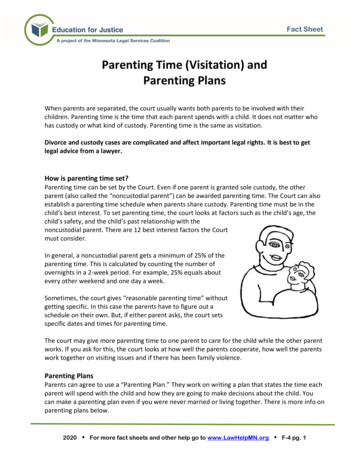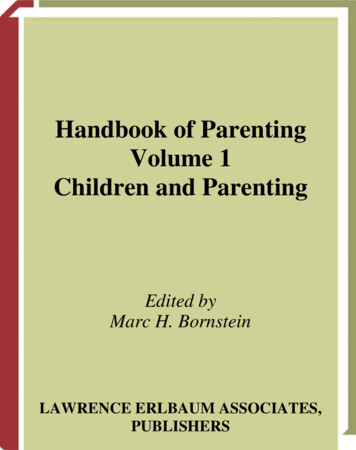
Transcription
General Information BookletGUARDIANSHIP, PARENTING,CUSTODY, ACCESS AND CONTACTRevised, January, 2017
Revised December 2012
GENERAL INFORMATION: GUARDIANSHIP,PARENTING, CUSTODY, ACCESS ANDCONTACTCONTENTSIntroduction . 1What is Guardianship? . 2Who is a Guardian? . 4What is Parenting? . 6What is Custody? . 8What is Access? . 10What is Contact? . 12How Does the Judge Make These Decisions? . 13The Actual Laws . 15Resolution Services and Court Staff cannot give you legal advice, orpredict the outcome of your case.This booklet provides general information only. You should speak toa lawyer for legal advice about your own situationGeneral Information: Guardianship, Parenting, Custody, Access and Contact
These instructions have been prepared for you by ResolutionServices. Contact us at:th7Calgaryfloor, Calgary Courts Centre601 - 5 Street SWPhone 403-297-6981Edmonton8 floor, Brownlee Building10365 – 97 StreetPhone 780-415-0404thGrande PrairieMain Floor, Court House10260 - 99 St.Phone: 780-833-4234Lethbridge1 Floor, Court House320 - 4 St. SLethbridge AB T1J 1Z8Phone: 403-388-3102Red DeerMain Floor, Court House4909 - 48 AvePhone: 403-340-7181Medicine HatCourt House460 First Street SEMedicine Hat, AB T1A 0A8Phone 403-529-8716stOutside these centres, call theResolution Services Contact Centre at 1-855-738-4747General Information: Guardianship, Parenting, Custody, Access and Contact
IntroductionIf your application deals with guardianship, parenting, custody, access orcontact, you should read this booklet before starting to fill out your courtforms.This booklet will give you general information about the law relating to theseissues, and the principles applied by the court when deciding mattersrelating to the care of children. This information is general in nature, and isnot intended to be an in-depth discussion of all legal issues relating tochildren.We recommend that you speak to a lawyer to find out how the law would beapplied to your situation.If you need further information, please contact the Resolution Services staff.They can answer questions you have about: steps for getting or changing a court order or opposing theseapplications; and general information and court procedures for other family lawmatters.What do the terms guardianship, parenting, custody, access and contactmean? Simply put, they are legal terms for the various relationships thatparents (and sometimes others) have with children.In Alberta, a child is any person who is under the age of 18. Otherprovinces have different rules for when a child becomes an adult, but if thechild is living in Alberta, it is Alberta’s rule that applies.The laws that discuss these issues in Alberta are The Divorce Act and TheFamily Law Act.The Divorce Act applies to parents who are or were married and havestarted an action under the Divorce Act. It continues to apply after theDivorce Judgment has been granted.The Family Law Act applies to everyone else who must make decisions abouta child.General Information: Guardianship, Parenting, Custody, Access and Contact1
What is Guardianship?A guardian of a child has certain entitlements (rights), responsibilities andpowers with respect to that child.A guardian is entitled: To be involved in making significant decisions about the child; and To have enough time with the child to exercise the powers andresponsibilities.A guardian is responsible: To take care of the child’s physical, psychological and emotionaldevelopment; and To make sure the child has medical care, food, clothing and shelter.A guardian has the power: To make day to day decisions about the child; To decide where the child will live; To make decisions about education and extracurricular activities; To make decisions about the child’s cultural, linguistic, religiousand spiritual upbringing; To decide who the child will live with and/or associate with; To decide if the child will work and if so, what kind of work; To provide consents where required by law; To receive and to respond to any notice required by law to begiven to a guardian; To deal with legal matters on behalf of the child; To appoint someone to act on the guardian’s behalf in anemergency situation, when the guardian is ill or absent; To receive health or educational information about the child; To exercise any other power that may be necessary to carry outthe guardian’s responsibilities.General Information: Guardianship, Parenting, Custody, Access and Contact2
The powers that a guardian has are not absolute. They may be limited inthree ways: There are laws that limit the guardians’ powers. For example, eventhough a guardian has the power to decide about the child’seducation, there are laws that say that your child must go toschool. If a guardian abandons or neglects their child, then Children andYouth Services may become involved and take steps to remove thechildren or supervise the guardians. If the guardians cannot agree on how the powers andresponsibilities will work between them, then the court can makethat decision for them in a Court Order, called a Parenting Order ora Custody and Access Order.General Information: Guardianship, Parenting, Custody, Access and Contact3
Who is a Guardian?The Family Law Act sets out who is a guardian of a child. Both parents ofthe child are guardians if: They were married to each other at the time the child was born; They were married to each other, but divorced less than 300 daysbefore the child was born; They lived together for at least 12 months and the child was bornwhile they were living together; They lived together for less than 12 months, but were in an adultinterdependent relationship, and the child was born during thatrelationship; or They married or became adult interdependent partners after thechild was born, but within one year of finding out about thepregnancy or the birth of the child. They signed an agreement that they would both be guardians.Example:Sandra and Steve are dating. Sandra becomes pregnant and theydecide to live together. Steve moves into Sandra’s one bedroomapartment and they share the rent, utilities and groceries. Sandradoes Steve’s laundry and Steve fixes Sandra’s car. They shop for babyitems together, and meet each other’s parents.Two weeks after the baby is born, they break up and Steve moves out.In this case, even though Sandra and Steve did not live together for12 months, they did have many of the key signs of an AdultInterdependent Relationship: They shared expenses.They divide household chores.They held themselves out as a couple.They had an intimate relationship.For those reasons, the court would likely find that they were in anAdult Interdependent Relationship and that both of them are guardiansof the child.General Information: Guardianship, Parenting, Custody, Access and Contact4
If the parents are not living together or married, then a parent is a guardianif that parent has shown an intention to assume the responsibilities of aguardian within one year of finding out about the pregnancy or the birth ofthe child. Some ways that a parent may show that intention are: The parent gives birth to the child. The parent voluntarily pays or offers to pay support (other thanas ordered by the court) to the birth mother or for the child. The parent gives some other kind of support or offers to givesuch support to the birth mother or for the child. The parent shows their intention to assume the responsibility of aguardian in some other way.Examples:Sue and Larry are dating. Sue gets pregnant and they break upbefore the child is born. Larry buys diapers and formula for thebaby and drops them off with Sue whenever he visits the baby.In this case, Larry would probably be found to be a guardian.Within the first year, he has shown that he wants to assume theresponsibility of a guardian by giving non-financial support; andvisiting the baby* * *Agnes and Herman are dating. Agnes gets pregnant and theybreak up. Herman is not involved with the baby, but does paythe child support that the court orders him to pay. When thechild is a teenager, he runs into Herman and they discover amutual interest in mechanics. Herman spends a lot of time withthe child from then on, and when he turns 16, Herman buys hima car.In this case, Herman is not a guardian. He has paid childsupport, but only as ordered by the court, not voluntarily. Hehas become involved with the child, but it was not within oneyear of finding out about the child.The Family Law Act also allows the court to make an order appointingsomeone to be a guardian of a child. That person does not have to be aparent of the child. It is possible for a child to have more than 2 guardians.General Information: Guardianship, Parenting, Custody, Access and Contact5
What is Parenting?“Parenting” is a term in the Family Law Act that applies when guardians donot live together. Normally, when guardians live together, they share all ofthe powers, entitlements and responsibilities for the children. But when theylive apart, they must come to terms with how the time with the children willbe shared and how decisions will be made.In some cases, the guardians are able to work things out betweenthemselves with just a verbal agreement. In other cases, they may be ableto work things out, but want to formalize the arrangements. They will thenenter into a “Parenting Agreement”, which is a contract between theguardians that sets out how much time the children will spend with each ofthem, and how decisions will be made.Tip:Many couples will make use of a mediator to help them reach an agreement.A mediator does not take sides or tell you what to do. Their role is to guidethe discussion between you, to help you reach agreement, and to make sureall the bases are covered.If the guardians are not able to agree, then they can go to court. In thatcase, the judge will hear from both of them, then will make a decision aboutthe time that the child will spend with each guardian and how decisions willbe made. The judge’s decision is set out in a Parenting Order.Parenting Arrangement: GUARDIANSHIP Parent 1Both parentsParent 2 Decide where to live. Decide which school togo to. Decide about whetheror not child can work.Make day to daydecisions when child isin this parent’s care.Time with the child:Monday – Friday, exceptfor hockey practices andgames. Consent to medicaltreatment.Attend parent-teacherinterviews.Decide about religion. Decide aboutextracurricular(hockey).Make day to daydecisions when child inthis parent’s care.Time with the child: Everyweekend and takes tohockey practices andgames.General Information: Guardianship, Parenting, Custody, Access and Contact6
Tip:Remember that a parenting order is between guardians, so if a non-parent(e.g. Grandma) is a guardian, they will be a party to the parenting order.General Information: Guardianship, Parenting, Custody, Access and Contact7
What is Custody?When parents are married, they are both guardians of their children andshare all of the powers, entitlements and responsibilities that are discussedabove.If they separate and file for divorce, the agreement or order that is madewill often use the terms “custody” and “access”.If there is no order or agreement in place, then married parents have “jointcustody”. That means that they make the decisions about the childrentogether and that they are both entitled to spend time with the children.Often, parents will continue the joint custody in their agreement or order,but will specify with whom the children will live and how the other parent’stime with the children will work. The parent with whom the children spendmost of their time is said to have “primary care and control” – which meansthat they make the day to day decisions most of the time. The other parenthas “access”, which means that they spend time with the children.Joint Custody Arrangement GUARDIANSHIP Parent 1 has primarycare and controlBoth parentsParent 2 has access Make day to daydecisions when child isin this parent’s care. Time with the child:Monday – Friday, exceptfor hockey practices andgames.Decide where to live.Decide which school togo to.Make day to daydecisions when child inthis parent’s care.Decide about whetheror not child can work.Consent to medicaltreatment.Attend parent-teacherinterviews.Decide about religion.Decide aboutextracurricular(hockey).Time with the child: Everyweekend and takes tohockey practices andgames.General Information: Guardianship, Parenting, Custody, Access and Contact8
The parents may agree or the court may order that one of the parents has“sole custody”. This means that one of the parents makes all of thedecisions about the children. In most cases, the other parent will still haveaccess.Sole Custody Arrangement GUARDIANSHIP Parent 1 has solecustody Decide where to live.Decide which school togo to.Both parentsParent 2 has access Make day to daydecisions when child inthis parent’s care.Decide about whetheror not child can work.Consent to medicaltreatment.Attend parent-teacherinterviews.Decide about religion.Decide aboutextracurricular(hockey). Make day to daydecisions when child isin this parent’s care.Time with the child:Monday – Friday, exceptfor hockey practices andgames.Time with the child: Everyweekend and takes tohockey practices andgames.Even though one parent has sole custody, they may not be able to make allthe decisions about the children on their own. The court order may haveterms that restrict their powers. For example, the order may say: The custodial parent may not move without the other parent’sconsent. The custodial parent may have to consult the other parent beforemaking decisions. The access parent may be allowed to make certain specificdecisions.General Information: Guardianship, Parenting, Custody, Access and Contact9
What is Access?Access is a term used in the Divorce Act, so, in Alberta, it will only apply todivorcing or divorced parents.Access refers to the time that the parent without custody (or primary care)has with the children.If the other parent has sole custody, then the access parent has only theright to make day to day decisions for the children when they are in theircare. For example, the access parent can decide what meals to serve orwhat activities the children will do, but may not make decisions on medicalcare or schooling.If the two parents have joint custody, then the access parent has the rightto make day to day decisions for the children when they are in their care,and also to participate in the major decisions about the children.Many court orders or agreements will simply say that the access parent has“reasonable” or “generous” or “liberal” access. What does that mean?Simply put, it means that the access arrangements are flexible, and that theparents are to work together to create a schedule that they both can accept.If this kind of arrangement does not work, they parents can create or thecourt can order specified access.Specified access means that the days and times of the access visits arespelled out in the agreement or order. Sometimes only some of the daysand times are spelled out, and the rest left as reasonable access. Othertimes, the order or agreement will be specific as to every access visit overthe course of the year.Example of a Specified Access Order:The Respondent shall have access to the children as follows: In every 14 day period, from Tuesday after school until Wednesdaymorning, then from Friday after school until Sunday noon, thenfrom Thursday after school until Friday morning, with the first such14 day period to commence Monday, September 6, 2010. In the event that the Respondent’s weekend falls on a longweekend, then the access shall be extended to Monday at noon. The regular access schedule shall be suspended during theChristmas vacation, Spring Break vacation and summer schoolvacation times.General Information: Guardianship, Parenting, Custody, Access and Contact10
Christmas school vacation shall be divided between the parties sothat the Respondent has the children for the first half of thevacation (including Christmas Day) in even numbered years, andthe second half of the vacation (not including Christmas Day) in oddnumbered years.The Respondent shall not have access to the children during SpringBreak, as the children routinely spend that time period with thematernal grandparents.Summer school vacation shall be divided between the parties sothat they each have the children for two – 2 week periods. TheRespondent shall provide the Applicant with his summer vacationschedule by May 1 of each year. If the parties cannot agree withrespect to the division of the summer vacation period, then theymay return to Court for a further Order.An access order or agreement can also have conditions or restrictions.Some examples: If the access parent has an alcohol problem or uses illegal drugs,the order may say that they cannot have use alcohol or illegaldrugs within a certain time before the access visit or during theaccess visit. If the child has health problems that make it difficult to bearound cigarette smoke, the order may say that the accessparent must make sure that no one smokes around the child. If the access parent is not set up to properly care for the child,the order may say that they cannot have overnight access untilthey have a bed for the child. In extreme cases, the order may say that the access must besupervised.Tip:Remember that custody and access orders are only made under the DivorceAct. In all other cases, the Order will be called a Parenting Order.General Information: Guardianship, Parenting, Custody, Access and Contact11
What is Contact?If you are not a guardian of a child, but want to be able to spend time withthe child, you can apply for Contact.Contact means simply that you can spend time with the child. That timemay be in person, or by telephone or by mail or e mail. You would have nodecision making powers with respect to the child.In most cases, a person applying for Contact must go through two courtapplications.First, they must ask for “leave to apply”. When deciding whether or not togrant leave to apply, the judge will look at the relationship that the personhas had with the child and whether or not the person actually needs a courtorder to allow them to spend time with the child.If the judge grants leave to apply, then the person must make a secondapplication to the court for the contact order.Before granting a contact order, the judge must be satisfied that: contact between the child and the person is in the child’s bestinterests; the child’s physical, psychological or emotional health may be putin danger if the contact is denied; and the guardians’ denial of contact is unreasonable.In some cases, the person wanting contact is allowed to skip the applicationfor leave, and go directly to the contact application. These cases are: a parent of the child. (This would be the case where the parentis not a guardian.) someone who was married to or in an Adult InterdependentRelationship with the guardian and stood in the place of a parentto the child. (i.e. a step-parent) a grandparent who has had a relationship with the child, but hasnow been cut off from the child because the parents haveseparated or because one of the parents has died.General Information: Guardianship, Parenting, Custody, Access and Contact12
How Does the Judge Make These Decisions?It is always best if the parents (or guardians) can make decisions about thecare of their children themselves. They are the ones that know and lovetheir children, and in most cases, are able to do what is best for theirchildren.In some cases, parents cannot agree, and must ask the court to decide forthem. In that case, the judge must decide, based on the best interests ofthe children.The Family Law Act sets out some tools for the judge to use when decidingwhat is in the child’s best interests. Most importantly, the judge must makesure to protect, as much as possible, the child’s physical, psychological andemotional safety.When making a decision, the judge must look at these factors: the child’s physical, psychological and emotional needs; the child’s need for stability; the child’s age and stage of development; who has been caring for the child up to now; the child’s heritage (i.e. their language, culture and religion); what the child wants (so long as it is not going to hurt the childto ask them that); the plans each person has for caring for and raising the child inthe future; any family violence; how strong the relationship is between the child and each party; the child’s relationships with other people in the household and inthe child’s life; the ability of each party to properly care for the child; how cooperative each party will be when it comes tocommunicating with the other; what each of the parties wants to happen; the benefit to the child in developing and/or maintaining arelationship with each of the parties;General Information: Guardianship, Parenting, Custody, Access and Contact13
how well each of the parties will exercise the powers,entitlements and responsibilities of a guardian; and any criminal charges or convictions.Tips: Once a court order is made, you must obey it. In many cases, parentswill, over time, come to different agreements with respect to their timewith the children or how decisions will be made. So long as both of youagree, this is fine, but the court order is still there, and either one of youare allowed to insist that you both go back to those terms. Parenting or custody orders are not meant to last until the child grows up.The arrangements that are made when a child is a toddler will not workonce they start school, and when they become a teenager, time with theirfriends is often more important to them than time with their parents. Atthe same time, parents may change jobs, move or otherwise need tochange the parenting schedules. If circumstances change, you canchange your parenting or custody order. If you agree, you can write up aconsent order, and ask a judge to sign. If you can’t agree, you will makea court application and the judge will decide for you. Sometimes the children will not want to follow the court order. In thosecases, it is up to you to make sure that they do, the same way you makesure they go to school or to the dentist, even if they do not want to.However, if you believe that it is not in their best interests to spend timewith the other parent, then you may want to go back to court and ask tochange the order. Parenting, custody or contact orders end once the child turns 18. Many people believe that once a child reaches a certain age, they candecide themselves where they want to live. This is not true. Until thechild turns 18, the decision is made by the parents or the court. Havingsaid that, the Family Law Act says that the court must take the child’swishes into account, and the older the child is, the more weight the courtwill give to the child’s wishes. But the decision / court application isalways made by the parents – never the child.General Information: Guardianship, Parenting, Custody, Access and Contact14
The Actual LawsIn this booklet, we have explained the laws in general terms. For morespecific information, the actual laws can be found at:The Divorce Act ml)The Family Law Act(http://www.qp.alberta.ca/1266.cfm?page F04P5.cfm&leg type Acts&isbncln 9780779765805)This publication has been prepared by Resolution Services, and providesgeneral information about the law as of the date it was written. It is notintended to provide you with legal advice. If you want advice on your case,speak to a lawyer.General Information: Guardianship, Parenting, Custody, Access and Contact15
Parent 1 Both parents Parent 2 Decide where to live. Decide which school to go to. Decide about whether or not child can work. Make day to day decisions when child is in this parent's care. Consent to medical treatment. Attend parent-teacher interviews. Decide about religion. Decide about extracurricular (hockey).
